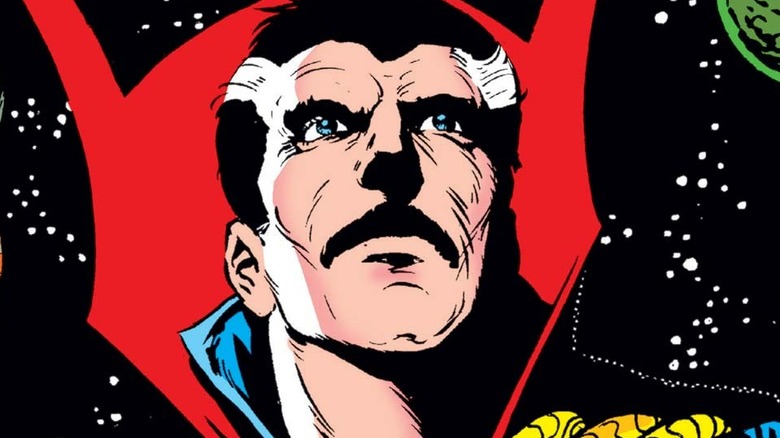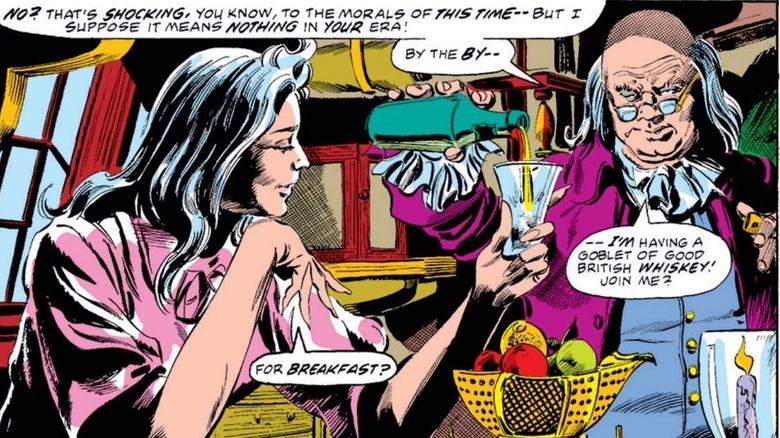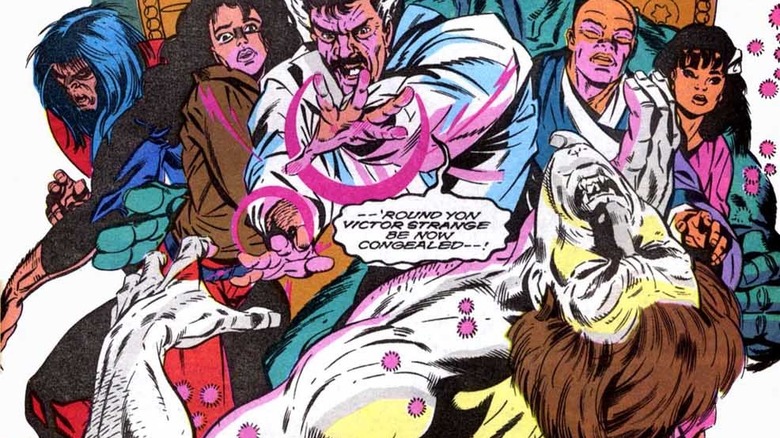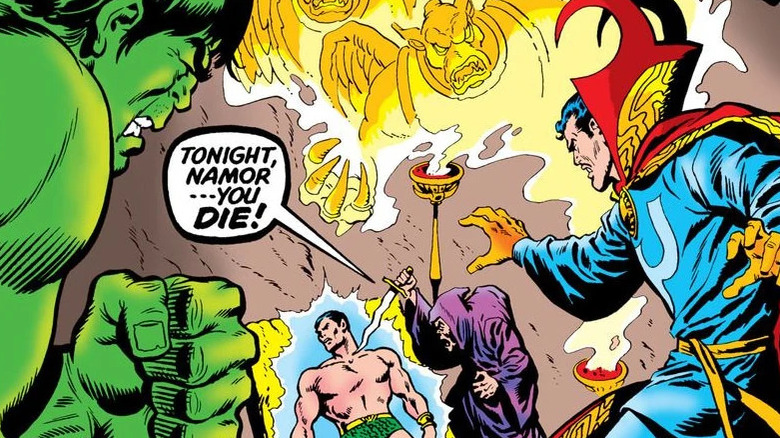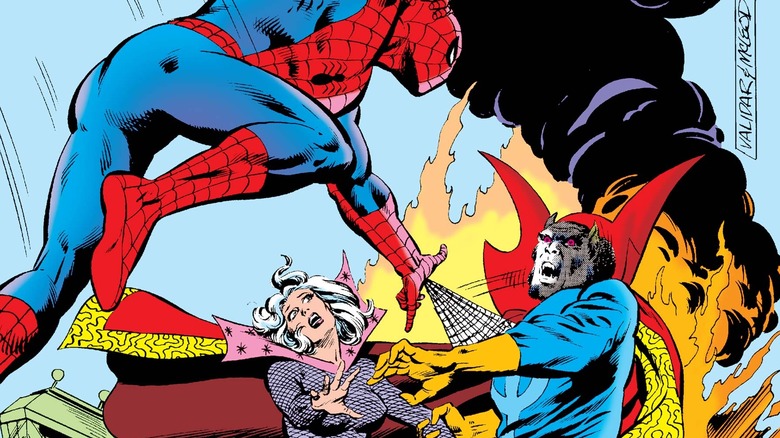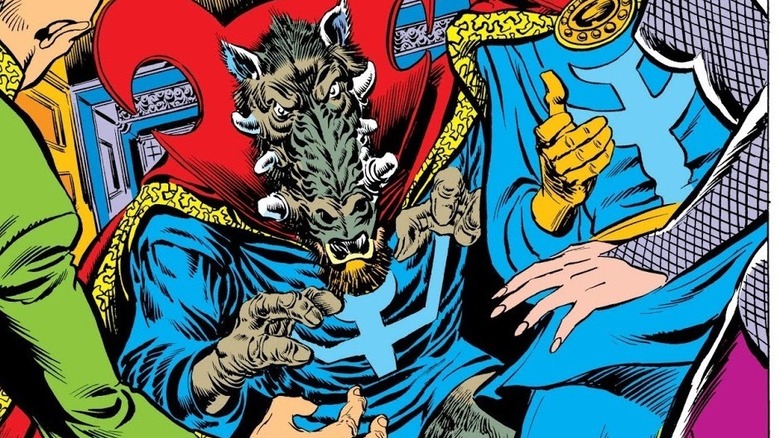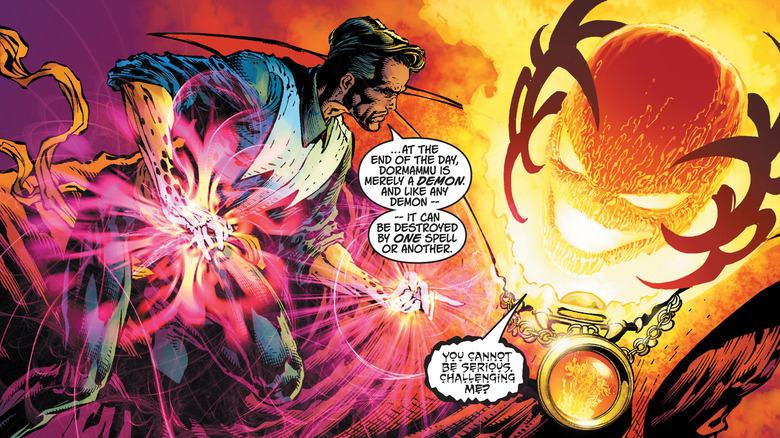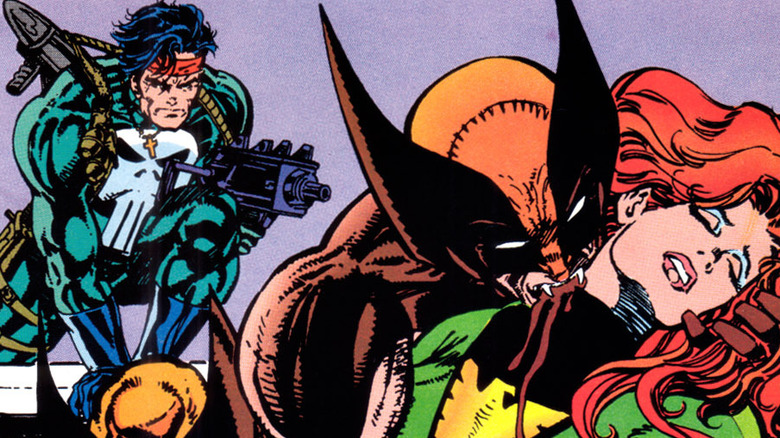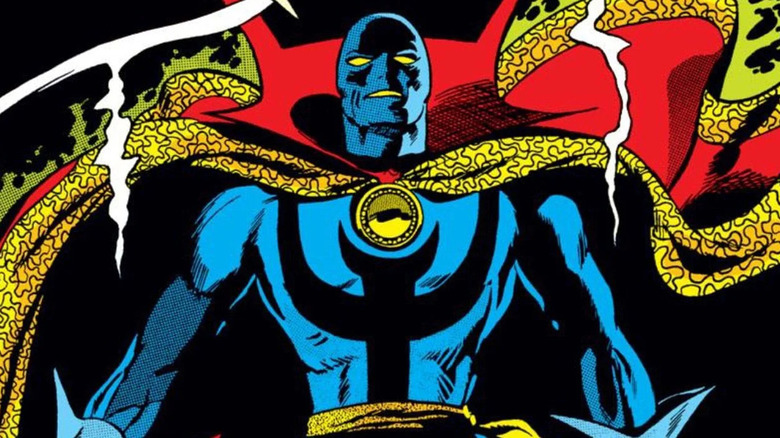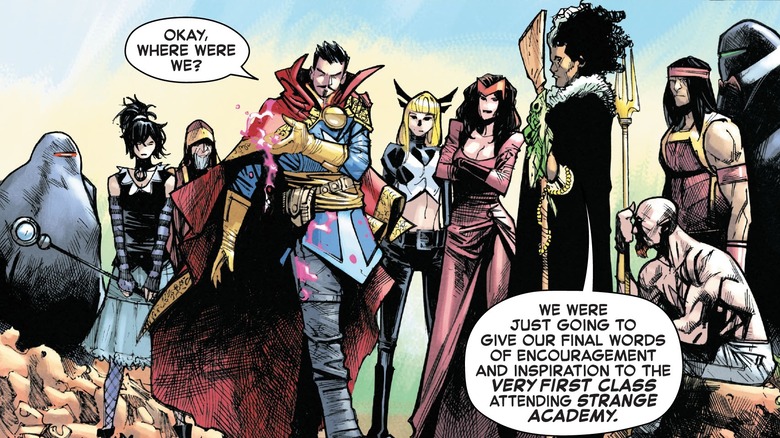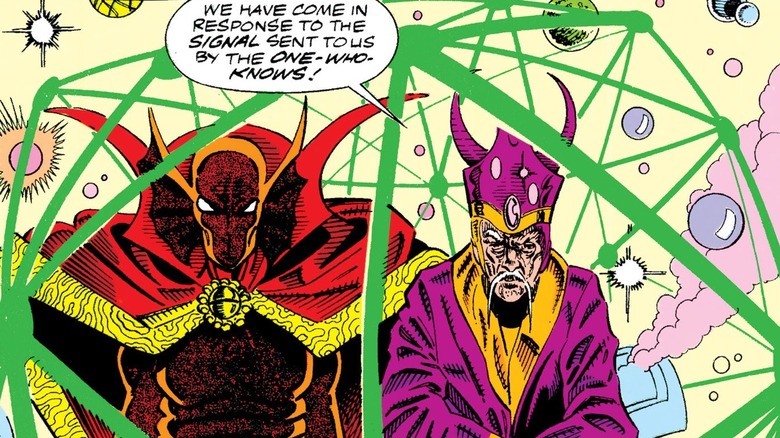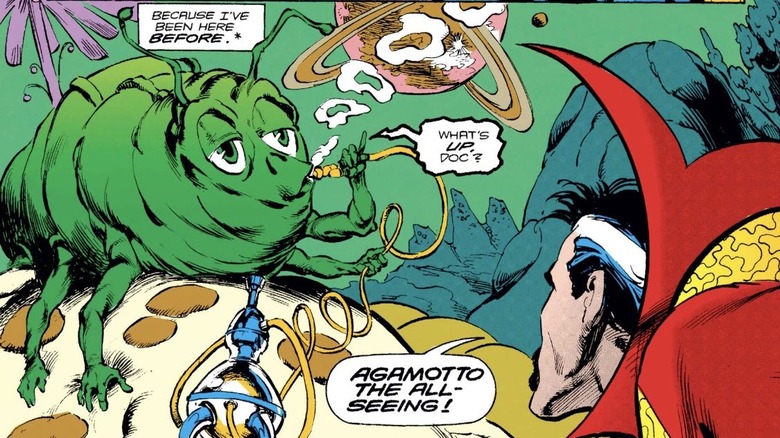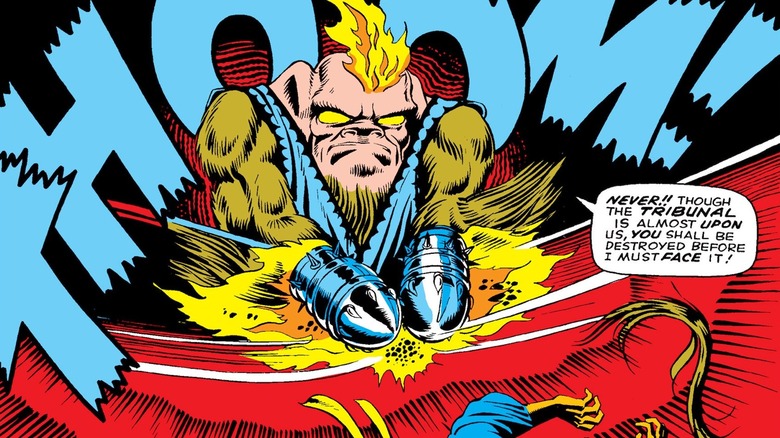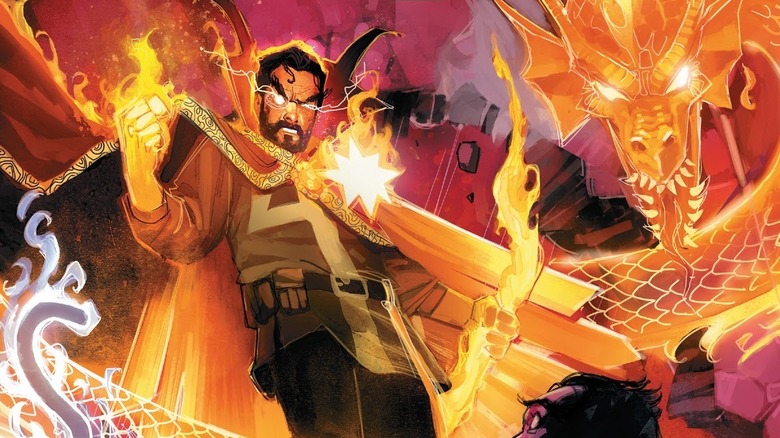Doctor Strange Stories You'll Never See On The Big Screen
Ever since he first appeared in 2016's "Doctor Strange," Doctor Stephen Strange has played a vital role in the Marvel Cinematic Universe. Beyond his ongoing movies, Strange has appeared in "Thor: Ragnarok," "Avengers: Infinity War," "Avengers: Endgame," and "Spider-Man: No Way Home." And he's likely to be around for a long while yet, too — in December 2021, Benedict Cumberbatch told USA Today that he'll happily keep playing the role for "as long as the character is interesting and challenging and doing fantastic things in the MCU."
It's an exciting time for Doctor Strange fans, then, and there are any number of weird and wonderful comic books that Kevin Feige and co. might draw upon for his upcoming MCU appearances. Who wouldn't leap at the chance to see Shuma-Gorath make his silver screen debut? Or witness the trippiest heights of Steve Ditko's first run of comics brought to film? Or even just enjoy a direct adaptation of one of Strange's more recent arcs, such as "Loki: Sorcerer Supreme" or "Death of Doctor Strange"?
That said, there are a handful of Strange tales that will likely never make it to movie theaters. Whether it's because they're too outlandish, too impractical, or simply too awful, these are the Doctor Strange stories you'll never see on the big screen.
The love triangle with Ben Franklin
Back in the early 1970s, Doctor Strange found a new writer in Steve Englehart. Beginning with "Marvel Premiere" and followed by the first run of "Doctor Strange," Englehart saw Strange's comics as an opportunity to delve into some of the more popular philosophical concepts of the time — what Britannica calls "spirituality, self-exploration, and consciousness-raising." For some reason, he also took the opportunity to have Strange meet Benjamin Franklin.
Englehart's valuable contribution to the Doctor Strange canon is undeniable, but his last bow as lead writer, in 1976's "Doctor Strange" #17-19, was utterly inexplicable. In these issues, Strange decides to teach his disciple, Clea, how to travel in time. After a brief sojourn to hang out with Francis Bacon in 1618, they decide to jump forward to 1775. Here, Strange comes into conflict with a magician named Stygyro, the lost city of Atlantis is found at last, and Clea ends up being seduced by the man whose face graces the hundred dollar bill.
Now, you could certainly argue that the MCU has gotten a little weirder lately: "WandaVision" is a delightful experiment in genre, the multiversal shenanigans in "Loki" are a genuine riot, and Oscar Isaac's British accent in "Moon Knight" pretty much speaks for itself. But we're going to take a guess that having Doctor Strange's pupil/lover engage in a soap opera-style love triangle with Ben Franklin might be a little too much for most fans' tastes.
Victor Strange, Stephen's secret vampire brother
Speaking of soap operas, how's this for a twist? In "Doctor Strange, Sorcerer Supreme" #10, a confrontation with Morbius the Living Vampire leads to the revelation that Stephen Strange has a secret long-lost vampire brother named Victor. Apparently, Strange's little bro has spent the last decade cryogenically frozen beneath a warehouse in New York, having been hit by a car during childhood. Since becoming a sorcerer, Strange has been using his abilities in a desperate attempt to bring his sibling back to life; throw in the Montesi Formula — a spell that Strange had previously used to wipe out all vampires in "Doctor Strange" #62 — as well as a new spell known as the "Vampiric Verses" and a whole heap of plot contrivance, and hey presto: Victor Strange is magically resurrected.
This is not Doctor Strange's finest hour, neither as a character nor as a comic book. Victor's existence comes out of absolutely nowhere, and he doesn't stick around for long either, making a few subsequent appearances before his final story in "Doctor Strange, Sorcerer Supreme" #56. It's hard to see a way in which this guy might fit into the MCU that wouldn't also seem forced and unnecessary, and there must be a million other paths Doctor Strange's character arc can follow before Marvel Studios has to resort to a twist as trite as this. If Kevin Feige knows what's up, he'll give Victor Strange to Sony for "Morbius 2" and forget this whole sorry saga ever happened.
The classic Defenders
Doctor Strange has featured in many different superhero teams over the years, from the Avengers to the Illuminati to the Midnight Sons. Perhaps his most famous group affiliation of all, however, is the Defenders.
Strange's first story with the Defenders can be found in 1971's "Marvel Feature" #1, which also marks the team's inception. This story sees Strange embroiled in a race against time to prevent a doomsday device from destroying the Earth. In order to do so, he enlists the help of Namor the Sub-Mariner and the Incredible Hulk. Once the day is saved at the end of the issue, the trio decide to remain loosely in cahoots, and Strange dubs them — you guessed it — "The Defenders." The team would later return in subsequent issues of "Marvel Feature," finally getting their own title, "Defenders" #1, in 1972.
There are two main obstacles in the way of these stories ever reaching the big screen. The first is that the name "Defenders" has already been co-opted by Netflix's Marvel Universe, and now that Matt Murdock and friends have been folded into the wider MCU, there's a good chance they'll come together again at some point in the future. The second is that the classic Defenders stalwarts simply have too much going on: outlets such as The Illuminerdi have reported that Namor is set to be a villain in "Black Panther: Wakanda Forever," Bruce Banner has his hands full with the upcoming "She-Hulk" series, and Doctor Strange has that whole madness-in-the-multiverse thing to deal with. Is there really much chance that these entirely unrelated characters will come together to form a team with a name everybody already knows? It seems doubtful.
Werewolf Doctor Strange
Launched in 1972, "Marvel Team-Up" was an ongoing run of comic books that brought together two or more superheroes each issue — one of whom was almost always Spider-Man — to fight some terrible threat. Over the years, the heroes featured alongside Spidey have included the Human Torch, Thor, Iron Man, Captain America, Black Panther, Daredevil, Hulk, Professor X, Man-Thing, Ms. Marvel, and, well, basically every major hero you can imagine. In "Marvel Team-Up" #80, Spider-Man meets Clea, and together they face off against ... Werewolf Doctor Strange.
Bet you didn't see that one coming. As it turns out, Strange has been turned into a werewolf as an unintended consequence of his alliance with the voodoo high priestess Marie Laveau in "Marvel Team-Up" #76. Luckily, with the help of Clea, Spidey, and the half-demon Satana, Strange returns to his old self in the very next issue.
Marvel Studios have actually sort of riffed on the concept of "Marvel Team-Up" with the three MCU "Spider-Man" movies, each of which had Peter Parker meet and fight alongside a different hero: in "Homecoming," it's Iron Man; in "Far From Home," it's Nick Fury; in "No Way Home," it's Doctor Strange. And while it seems unlikely that future "Spider-Man" movies will retread old ground in this sense, it seems even less likely that they'll do so by having Spidey and Clea battle a lycanthropic Stephen Strange.
Doctor Stranger Yet
For a while, it really seemed like Doctor Strange had a problem with anthropomorphism. "Doctor Strange" #25 begins with Clea and Wong rescuing Strange from the Quadriverse, an uncanny dimension filled with unspeakably bizarre sights and sounds. When they return to Earth, however, they discover that, instead of humans, the world is populated by billions of half-human, half-animal creatures. The trio also discovers a new inhabitant of the Sanctum Santorum: a Sorcerer Supreme with a boar's head who calls himself "Doctor Stranger Yet." Fear not, though, for, in "Doctor Strange" #28, the original Strange saves the day and restores the old order after defeating the god-like In-Betweener in battle.
It's all very, very odd. The Quadriverse scenes in the run-up to this arc are actually pretty great, being equal parts creepy and intriguing, and that whole arc would play out pretty well on-screen. (There's even some precedent for this, as the "Marvel Studios Visual Dictionary" cites the Quadriverse as one of the realities Strange visits in "Doctor Strange.") But forcing Strange and his allies into what basically amounts to a live-action adaptation of "BoJack Horseman" is probably a bridge too far for the franchise — no matter how much fun the name "Doctor Strange Yet" might be.
The infamous Ultimatum story
Ah, "Ultimatum." Described by an IGN critic as "the worst comic I have ever read," this near-universally reviled event takes place in the Marvel Ultimate Universe and is best known for almost single-handedly ruining Earth-1610 for many fans. The dialogue is corny, the pacing is a mess, and the art isn't all that great either. But perhaps the worst sin committed by Jeph Loeb during "Ultimatum" is the gratuitous and downright upsetting way in which he killed off many of Marvel's most popular heroes.
While "Ultimatum" is not a Doctor Strange story by any stretch of the imagination, it's worth mentioning because the death of Stephen Strange, Jr. provides one of the event's most notorious moments. In "Ultimatum" #4, a wave of destruction unleashed by Magneto has engulfed the world; one unintended consequence of this is that Dormammu, the Lord of the Dark Dimension, is unleashed upon New York City. As you might expect, Doctor Strange soon emerges to face his old foe, and the two come to blows in a truly epic — oh, no, wait, it's already over. Dormammu squeezes Strange with his own sash and makes his head explode, and that's the end of the Sorcerer Supreme.
Loeb's ending for Ultimate Strange is both disturbing and frustrating, and serves practically no purpose in the greater story. His brief arc — and, in fact, "Ultimatum" in general — constitutes a grim chapter in the history of Marvel, and the world will be a happier place if it never comes close to reaching the silver screen. Hopefully the top brass at Marvel Studios are well aware of this.
What if Wolverine was Lord of the Vampires?
Now that the MCU has its own adaptation of the ongoing series "What If...?", it's likely that many fans will be drawn to the original comic books. Across the numerous volumes of "What If...?" comics, they'll find such intriguing concepts as "What if Doctor Doom had become a hero?", "What if the Avengers had never been?", and "What if Aunt May had died instead of Uncle Ben?"
Among the more obscure questions posed by this series is "What if Wolverine was Lord of the Vampires?", which can be found in "What If...?" Vol. 2 #24. The story mostly revolves around Doctor Strange, the Punisher, and Wolverine, the latter of whom becomes Lord of the Vampires after defeating Dracula in combat. Long story short, Strange is murdered by an undead Juggernaut, uses his spirit to guide the Punisher in taking down the vampires, and finally helps Logan break free of his own evil aura.
Now, it should be obvious why this story — and most "What If...?" tales, for that matter — won't be getting the movie treatment anytime soon. There is a chance it might hit the small screen in future, courtesy of the "What If...?" MCU series, but we wouldn't bet on that, either. That's because this issue runs a little too close to the premise of "Marvel Zombies," which has already been adapted into a perfectly decent episode of "What If...?"
Spandex Strange
The adventures of Stephen Strange make for some of the most exciting and enjoyable comics Marvel has ever produced, and the comics of the early '60s are among his finest stories. Sadly, the fact is that not all fans felt the same way at the time, and, by 1968, sales of "Doctor Strange" were flagging. Concerned by the Sorcerer Supreme's ever-waning popularity, Marvel decided to bring him more into line with the studio's A-list heroes.
In "Doctor Strange" #177, Strange and Clea are exiled to another dimension by servants of the demon Satannish. At the same time, the villainous Asmodeus takes on Strange's identity, preventing the real Strange from returning. In order to return to Earth, Strange himself takes a new form, which includes a spandex-style suit and a blue mask to match. This new costume would remain right up to the cancellation of "Doctor Strange" in 1969, before being unceremoniously dumped in "Marvel Feature" #1.
Giving Doctor Strange a more traditional superhero costume (and a secret identity too, as little sense as that makes) didn't exactly do wonders for the character's fortunes, and his masked days have since been relegated to a footnote in the history of Marvel Comics. If you're hoping to see the live-action Strange escape his next predicament using the power of costume changes — well, don't hold your breath.
Strange Academy
In 2020, Marvel Comics launched "Strange Academy." The series follows a group of youngsters who attend a school for sorcerers set up by Doctor Strange and staffed by such Marvel mystics as Doctor Voodoo, the Ancient One, Agatha Harkness, Magik, Wanda Maximoff, and, of course, Strange himself. Along the way they forge friendships, learn the extent of their abilities, and face off against a growing threat to the Academy's existence. You know how it goes. In fact, the reason why you know how it goes is most likely because you've seen a very similar story play out before, both in comics and on the big screen.
Luckily, the talents of writer/illustrator duo Skottie Young and Humberto Ramos prevent "Strange Academy" from feeling too much like Marvel's many, many X-Men comics, but the comparison is nonetheless easy to make. Equally, the notion of young superheroes joining forces — some of whom are related to famous faces in the Marvel Universe — isn't entirely unlike that found in "Young Avengers" and its follow-up titles. And, since it appears that the MCU is setting up the pieces for both an "X-Men" project and potentially a "Young Avengers" project, it's particularly doubtful that "Strange Academy" will see the light of day.
Krugarr, Sorcerer Supreme
One of a race of aliens known as the Lem, Krugarr is first introduced in 1990's "Guardians of the Galaxy" Annual #1. In this story, the Guardians of the 31st Century — Starhawk, Charlie-27, Martinex, Yondu, and Vance Astro — go back in time to destroy their enemy, Korvac, as a child. There, they are visited by a man calling himself the Ancient One and his apprentice, Krugarr. As it turns out, this Ancient One is Stephen Strange, while Krugarr has taken on the mantle of Sorcerer Supreme.
Later, in "Guardians of the Galaxy" #36-37, the team faces off against Dormammu, prompting Strange and Krugarr to come to their aid once more. During their duel, the Dread One finally kills Strange, but Krugarr steps up and defeats Dormammu alongside the Guardians. After that, he continues in his role as Sorcerer Supreme alongside the Inhuman Talon, who studies as his apprentice.
Funnily enough, Krugarr actually exists in the MCU already — he's the fish-like sorcerer who appears as head of a Ravager clan in "Guardians of the Galaxy Vol. 2." While he might play a more significant role in a future "Guardians" project, it feels like it'd require quite the leap to connect Krugarr to the MCU's Doctor Strange, and having him actually become his main apprentice (and eventual successor) is probably out of the question entirely.
Doctor Strange in Wonderland
The influence of psychedelia on the world of "Doctor Strange" is hardly subtle. From Strange's near-nonsensical invocations to his bizarre roster of foes to the artwork of Steve Ditko and his successors, these comic books are steeped in weirdness. So maybe it was inevitable that they would pay tribute to one of literature's other great trips: "Alice in Wonderland."
In "Doctor Strange" #1, Strange is transported inside the Orb of Agomotto after surviving an assassination attempt by Silver Dagger. There, he meets a hookah-smoking caterpillar who claims to be real, "at least, for a world where nothing is real." This, of course, is a direct reference to the Caterpillar in Lewis Carroll's story, who frustrates Alice during her adventure in Wonderland. The Caterpillar returns in "Doctor Strange, Sorcerer Supreme" #7, and it soon revealed that he is, in fact, Agomotto himself. These same issue makes reference to "Tweedle-Dumb and Tweedle-Dumber" and uses the term "Mad as a Hatter." It is, for all intents and purposes, as close as a Marvel superhero has ever come to starring in an "Alice in Wonderland" adaptation.
Since Carroll's stories are in the public domain, Marvel Studios could actually recreate all of this in a future "Doctor Strange" project. But you've got to wonder whether the inclusion of actual "Alice in Wonderland" characters in a movie that's trying so hard to be trippy could be seen as too on-the-nose. Subtlety can be a good thing, after all.
Zom
In 1967, "Strange Tales" #156-157 introduced a new villain to the "Doctor Strange" mythos, one who has not been properly seen since: Zom. This monstrous beast is summoned by Strange and the Ancient One to help in their fight against Umar, the wrathful sister of Dormammu; while he gives her enough of a fright to send her packing, it quickly becomes clear that Zom is out of control and too powerful to stop. Only the interference of the omnipotent Living Tribunal is enough to reverse the damage.
There's something genuinely terrifying about Zom. His unquenchable thirst for destruction and stated intention of spreading across the universe is one thing, but the reveal that it once took Dormammu and Eternity to capture him is another. The need to bring in one of the most powerful beings in the Marvel multiverse to finally stop him is simply the final testament to Zom's unspeakable strength.
Introducing a plot beat similar to this to a future "Doctor Strange" movie would no doubt make for a heck of a climax, even if "Thor: Ragnarok" sort of did it already. Let's be honest here, though: Zom also looks absolutely ridiculous, and having Strange and the Ancient One bungle their battle against evil by unleashing an all-powerful flaming glam-monkey is absolutely not the climax we need from "Doctor Strange 3."
Doctor Strange: Damnation
"Doctor Strange: Damnation" is one of the best Doctor Strange stories of recent years. Published in 2018, this incredibly stylish crossover arc tackles the aftermath of the "Secret Empire" event, in which Stephen Strange brings the entire population of Las Vegas back from the dead. Before long, though, this miracle is complicated by the appearance of Mephisto, who quickly sets up shop and begins to exert his demonic influence on the newly-resurrected populace.
Mephisto has yet to make his debut in the MCU, and we can only hope that his eventual appearance comes in a story as frightening and thrilling as this. Sadly, we'd also wager that "Damnation" won't be given a full-blown adaptation. The formation of the team of Ghost Riders (Falcon, Captain Marvel, Thor, Hawkeye, and Black Panther) and its opposing team of heroes (Blade, Moon Knight, Elsa Bloodstone, Doctor Voodoo, Man-Thing, Iron Fist, and Ghost Rider) sits at the heart of this story, but it also represents the kind of flex you'd need a full-blown "Avengers" movie to pull off. Sadly, the chances of Marvel Studios centering one of those projects around what is essentially an epilogue, albeit an epic one, seem low. What's more, Strange's eerie journey into Mephisto's necrotic realm in "Doctor Strange" #388 and Johnny Blaze's conquest of hell in "Damnation: Ghost Rider — Johnny Blaze" #1 provide some of the story's most gripping sequences, but it's hard to see how a cinematic adaptation could do them justice.
Maybe there's a universe out there in which certain elements of this arc make it to the big screen — we sure hope so, at least — but, in terms of straight adaptations, it's probably fair to say that "Damnation" is one of those stories that only a comic book can really pull off.
